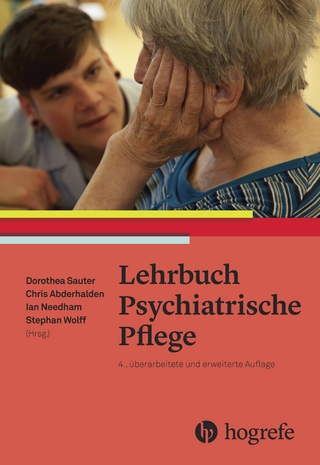
Understanding Children and Young People's Mental Health
Wiley-Blackwell (Verlag)
978-0-470-72345-6 (ISBN)
Understanding Children and Young People's Mental Health has been designed to help the student and newly qualified health care professional to familiarise themselves with the key theoretical frameworks underpinning the field of children and young people's mental health. It explores the mental health challenges that children and young people face, and how we as adults can work alongside them to help them face and overcome such challenges. This book provides comprehensive information on the theory and practice of particular mental health difficulties which children and young people may have to face, including self-harm, depression, suicide, child abuse, eating disorders, substance misuse, and early onset psychosis. Understanding Children and Young People's Mental Health is essential reading for pre-registration students in nursing and healthcare on child and mental health branches, and for newly qualified nursing, health and social care practitioners who work with children and young people.
Brings together specialist practitioners and academics in the field
Incorporates the latest guidelines and policies
Practical and accessible in style with learning outcomes, activities, examples and recommended reading in each chapter
Anne Claveirole is a Lecturer / Researcher in Children and Young People's Mental Health at Edinburgh Napier University. Martin Gaughan isa Lecturer in Children and Young People's Mental Health at Edinburgh Napier University.
Notes on Contributors ix
Foreword xiii
Acknowledgements xvii
Introduction 1
1 Setting the scene 4
Anne Claveirole
1.1 Introduction 4
1.2 Social context 5
1.3 Children and young people’s mental health 13
1.4 ‘Every Child Matters’: What can we do to help? 20
1.5 Conclusion 27
2 The family 29
Duncan Tennant and Anne Claveirole
2.1 Introduction 29
2.2 What is ‘normal’ family functioning? 30
2.3 The family life cycle 33
2.4 Family structure 37
2.5 Recent developments: narrative approaches to family therapy 39
2.6 Attachment and family therapy 41
2.7 Parenting support and education 42
2.8 Conclusion 44
3 Psychosocial development 46
Geraldine Jones
3.1 Introduction 46
3.2 Theories of development 47
3.3 Infant attachment 47
3.4 Adolescent identity formation 51
3.5 Adolescent self-esteem 54
3.6 Adolescent reasoning ability 55
3.7 Adolescent egocentrism 56
3.8 The psychological impact of puberty 57
3.9 Adolescent brain development 58
3.10 The value of contextual theories in explaining development of children and adolescents 59
3.11 The PVEST model 60
3.12 Conclusion 63
4 Self-harm 64
Martin Gaughan
4.1 Introduction 64
4.2 What is self-harm? 65
4.3 How common is self-harm? 66
4.4 Vulnerability and resilience 68
4.5 Promoting resilience 69
4.6 Models of self-harm 71
4.7 Assessment 74
4.8 Intervention 76
4.9 Informal support 77
4.10 Promoting positive behaviour 77
4.11 Self-help 78
4.12 Making access easier 79
4.13 Talking therapies 80
4.14 The personal impact of working alongside children and young people who self-harm 83
4.15 Conclusion 84
5 Depression 87
Martin Gaughan
5.1 Introduction 87
5.2 Defining depression 88
5.3 Prevalence 90
5.4 Vulnerability 91
5.5 Assessment 93
5.6 Symptoms of depression in children and young people 95
5.7 Protective factors and promoting resilience 98
5.8 Interventions 99
5.9 Cognitive–behaviour therapy 99
5.10 Interpersonal psychotherapy for depressed adolescents 100
5.11 Medication 101
5.12 Psychodynamics 103
5.13 What else helps? 104
5.14 The family 105
5.15 Conclusion 105
6 Suicide 108
Martin Gaughan
6.1 Introduction 108
6.2 What is suicide? 109
6.3 How common is suicide? 109
6.4 Vulnerability 111
6.5 Resilience 115
6.6 Risk assessment 117
6.7 Models of assessment and intervention 118
6.8 Applied suicide and intervention skills training 120
6.9 Skills-based training on risk management 121
6.10 Intervention 122
6.11 Prevention 125
6.12 Postvention 127
6.13 Conclusion 128
7 Child abuse and child protection 132
Julie Hendry and Marlene Macinnes
7.1 Introduction 132
7.2 Definitions of child abuse 133
7.3 Incidence and prevalence 136
7.4 Risk factors 137
7.5 Policy 139
7.6 Assessment 139
7.7 Prevention 144
7.8 Interventions 145
7.9 Conclusion 147
8 Eating disorders 149
Gavin Cullen
8.1 Introduction 149
8.2 What are eating disorders? 150
8.3 How common are eating disorders? 153
8.4 What causes eating disorders? 154
8.5 Resilience factors 158
8.6 Assessment 159
8.7 Interventions 161
8.8 Psychological support 161
8.9 Conclusion 163
9 Early onset psychosis 165
Martin Gaughan
9.1 Introduction 165
9.2 Time to change? 166
9.3 Prevalence 167
9.4 Vulnerability to psychosis 168
9.5 Early and very early onset psychosis 171
9.6 Phases of psychosis 172
9.7 Prevention and early intervention 173
9.8 Assessment 174
9.9 Interventions 177
9.10 Drug treatment 178
9.11 Effectiveness of medication 179
9.12 Side effects 180
9.13 Talking therapies 182
9.14 Promoting resilience, staying well and recovery 184
9.15 Involving the family 186
9.16 Conclusion 188
10 ADHD 191
Lorna Jones and Anne Claveirole
10.1 Introduction 191
10.2 What is ADHD? 192
10.3 The experience of ADHD 192
10.4 ADHD as a diagnostic category 194
10.5 Prevalence 195
10.6 Risk factors 196
10.7 Resilience: factors affecting outcome 200
10.8 Assessment 201
10.9 Interventions 205
10.10 Conclusion 213
11 Autistic spectrum disorders 217
Gillian Marshall-McConnell and Anne Claveirole
11.1 Introduction 217
11.2 Definition and classification 218
11.3 Prevalence 222
11.4 Risk factors/causation theories 223
11.5 Associated problems 226
11.6 Development 230
11.7 Assessment and diagnosis 233
11.8 Management of care 234
11.9 Conclusion 238
12 Misuse of substances 239
Liz Brodie and Jayne Reed
12.1 Introduction 239
12.2 Substance use and substance misuse 240
12.3 Prevalence 241
12.4 Patterns of use and misuse in children and young people 242
12.5 Vulnerability and resilience 244
12.6 Environmental and family factors 245
12.7 Early intervention and recognition 246
12.8 Assessment 246
12.9 Intervention 249
12.10 Conclusion 254
References 256
Index 305
| Erscheint lt. Verlag | 2.11.2010 |
|---|---|
| Verlagsort | Hoboken |
| Sprache | englisch |
| Maße | 168 x 245 mm |
| Gewicht | 535 g |
| Themenwelt | Pflege ► Fachpflege ► Neurologie / Psychiatrie |
| Medizin / Pharmazie ► Pflege ► Kinderkrankenpflege | |
| ISBN-10 | 0-470-72345-9 / 0470723459 |
| ISBN-13 | 978-0-470-72345-6 / 9780470723456 |
| Zustand | Neuware |
| Haben Sie eine Frage zum Produkt? |
aus dem Bereich


